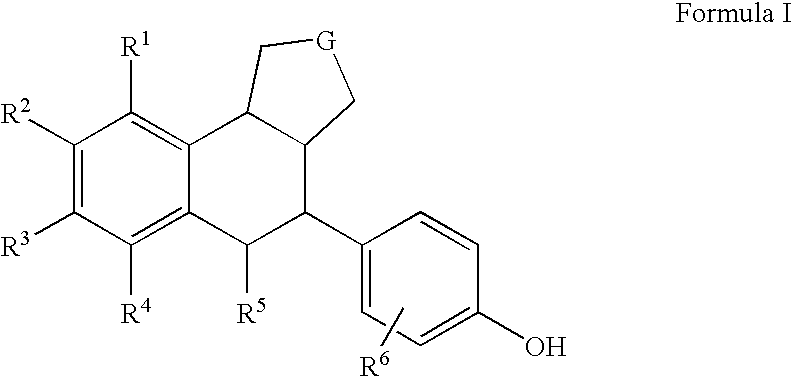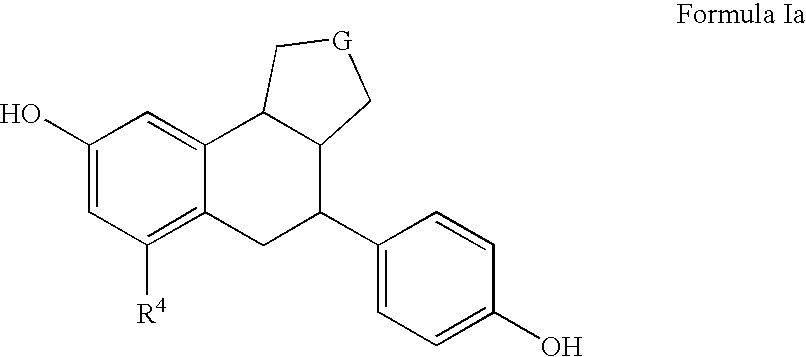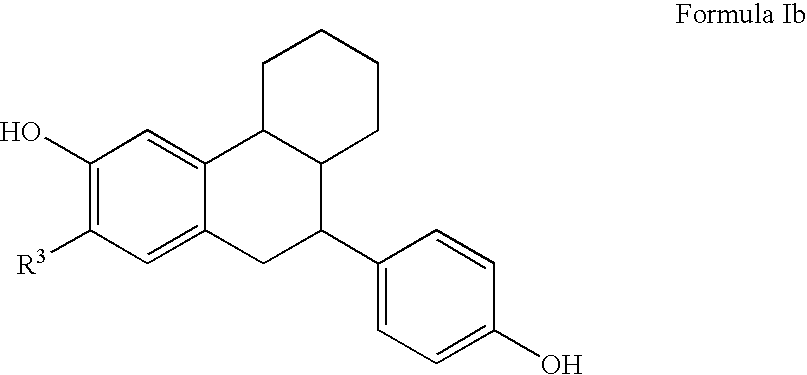Substituted tetralins as selective estrogen receptor-β agonists
a technology of er- receptor and tetralin, which is applied in the field of substituting tetralins as selective estrogen receptor- agonist compounds, can solve the problems of hesitation or delay in starting the urine flow, increase the frequency of urination, and poor urine stream, and achieve the effect of agonizing the function of the er- receptor
- Summary
- Abstract
- Description
- Claims
- Application Information
AI Technical Summary
Benefits of technology
Problems solved by technology
Method used
Image
Examples
preparation 1
[2-(3-Methoxy-phenyl)-cyclohexylidene]-acetic acid ethyl ester
[0085]
[0086]Combine 2-(3-methoxyphenyl)-cyclohexanone (5.0 g, 24.5 mmol), carbethoxymethylene triphenylphosphorane (15.4 g, 44.1 mmol), and toluene (150 mL), stir and heat at reflux. After 22 hours, cool to ambient temperature and concentrate under vacuum. Add ether and filter off the triphenylphosphine oxide precipitate and concentrate the ether filtrate. Flash chromatograph with 0% to 10% ethyl acetate / hexanes to yield the titled compound (6.71 g, 99%) as a clear oil. TLC Rf=0.58 in 8:1 hexanes:ethyl acetate. 1H NMR (CDCl3): 7.25 (m, 1H), 6.81-6.79 (m, 3H), 6.73 (s, 1H), 5.14 (s, 1H), 4.07 (q, J=14.4, 7.2, 2H), 3.80 (s, 3H), 3.80-3.69 (m, 1H), 3.39-3.36 (m, 1H), 2.20-2.16 (m, 1H), 2.06-2.03 (m, 1H), 1.96-1.87 (m, 3H), 1.65-1.54 (m, 2H), 1.2 (t, J=1.2, 8, 3H).
preparation 2
[2-(3-Methoxy-phenyl)-cyclohex-1-enyl]-acetic acid ethyl ester
[0087]
[0088]Combine [2-(3-methoxy-phenyl)-cyclohexylidene]-acetic acid ethyl ester (839.4 mg, 3.06 mmol), sodium ethoxide (62.5 mg, 0.92 mmol), and DMSO (6.0 mL), stir, and heat at 100° C. After 2 hours, cool to ambient temperature and extract the organic layer with ethyl acetate. Wash the ethyl acetate layer 5× with brine and dry the organic layer over sodium sulfate, and concentrate in vacuo to yield the titled compound (769.6 mg, 92%) as a clear oil. TLC Rf=0.58 in 8:1 hexanes:ethyl acetate. 1H NMR (CDCl3): 7.21 (m, 1H), 6.75 (m, 3H), 4.11 (q, 2H, J=7.2 Hz), 3.79 (s, 3H), 2.91 (s, 2H), 2.28 (m, 2H), 2.12 (m, 2H), 1.72 (m, 4H), 1.24 (t, 3H, J=7.3 Hz).
preparation 3
[2-(3-Methoxy-phenyl)-cyclohexyl]-acetic acid ethyl ester
[0089]
[0090]Combine [2-(3-methoxy-phenyl)-cyclohex-1-enyl]-acetic acid ethyl ester (9.91 g, 36.0 mmol), 10% Pd on carbon (2.06 g, 14.4 mmol), and ethanol (90 mL) and tetrahydrofuran (5 mL), degas, and add 50 psi H2 at room temperature. After 18 hours, filter off the Pd catalyst over celite eluting with ethyl acetate. Concentrate and flash chromatograph with 0% to 20% ethyl acetate / hexanes to yield the titled compound (8.89 g, 89%) as a clear oil. TLC Rf=0.42 in 6:1 hexanes:ethyl acetate. 1H NMR (CDCl3):1H NMR (CDCl3): 7.21 (t, 1H, J=8.1 Hz), 6.78 (d, 2H, J=7.5 Hz), 6.72 (s, 1H), 3.98 (q, 2H, J=7.0 Hz), 3.80 (m, 3H), 2.89 (m, 1H), 2.51 (m, 1H), 2.31 (m, 1H), 1.97 (m, 1H), 1.88 (m, 1H), 1.72 (m, 4H), 1.44 (m, 3H), 1.16 (t, 3H, J=6.6 Hz).
PUM
 Login to View More
Login to View More Abstract
Description
Claims
Application Information
 Login to View More
Login to View More - R&D
- Intellectual Property
- Life Sciences
- Materials
- Tech Scout
- Unparalleled Data Quality
- Higher Quality Content
- 60% Fewer Hallucinations
Browse by: Latest US Patents, China's latest patents, Technical Efficacy Thesaurus, Application Domain, Technology Topic, Popular Technical Reports.
© 2025 PatSnap. All rights reserved.Legal|Privacy policy|Modern Slavery Act Transparency Statement|Sitemap|About US| Contact US: help@patsnap.com



